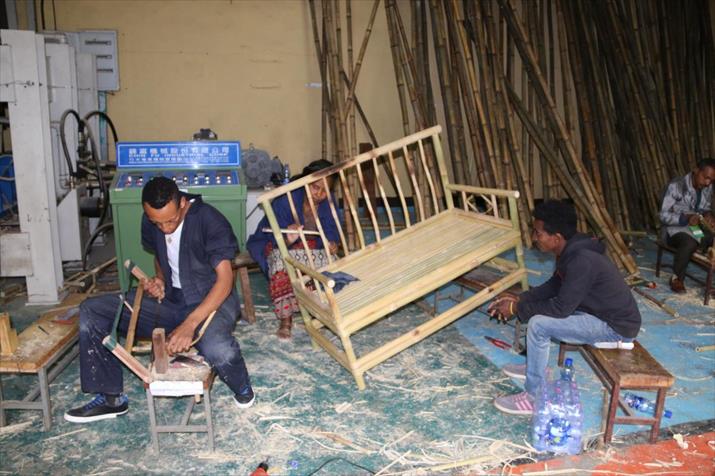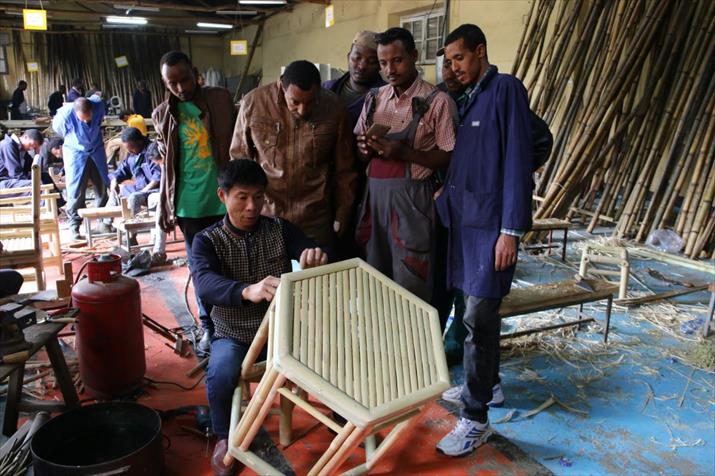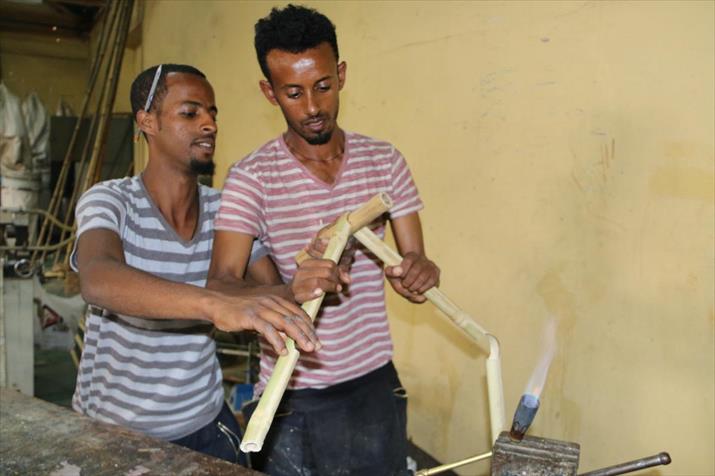|
||||||||||
| Home Nation World Business Opinion Lifestyle ChinAfrica Multimedia Columnists Documents Special Reports |
|
||||||||||
| Home Nation World Business Opinion Lifestyle ChinAfrica Multimedia Columnists Documents Special Reports |
| Lifestyle |
| Mining the Green Gold |
| Ethiopian and Chinese bamboo craftsmen work to develop the untapped potential of Africa's largest bamboo forests |
| By Xia Yuanyuan | VOL.9 September 2017 ·2017-08-31 |

Ethiopia artisans learn traditional Xiaoyu bamboo manufacturing techniques to improve products’ resilience and durability
Craftsmanship, it is said, is the art of creating beauty out of something raw - such as rough poles of bamboo. The bamboo is first cut, then measured and drilled. Pieces are attached and screwed together, lacquer is applied and - ta-dah! - in just a few hours, an exquisite bamboo chair has taken shape.
Addisu Hailu is among the appreciative audience of Ethiopian artisans who marvel at the superb skills and speed of their Chinese counterparts - senior bamboo craftsmen from Yiyang in south China's Hunan Province, a city known as the country's "bamboo capital."
"It is quite different from our technique," said Addisu, the owner of SA Bamboo Manufacturing Plc. based in Addis Ababa, capital of Ethiopia. He used to produce bamboo furniture himself, but decided to suspend production due to the excessive homogeneity of Ethiopia's bamboo market.
"The design and manufacturing of most bamboo products in Ethiopia are similar. If I can't do it in a more unique and better way, I would rather quit," he said. But Addisu says he has now regained confidence in bamboo manufacturing thanks to the Chinese peers he met.
Addisu was among the 41 trainees who took part in the 2017 Training Workshop on Bamboo Cultivation and Utilization, sponsored by the Ministry of Commerce of China and held by the International Network for Bamboo and Rattan (INBAR) and the Ethiopian Federal Micro and Small Enterprise Development Agency (FeMSEDA) in Addis Ababa from June 13 to July 15.
The training focused on bamboo furniture design and production, bamboo protection and other practical technology to promote the sustainable development of Ethiopia's bamboo industry. The ultimate goal is to help local artisans such as Addisu transform abundant bamboo resources into high-value products.
A versatile resource with great potential
Serving as fuel, cooking utensil and construction material, bamboo has multiple uses. Long renowned for its cultural significance across much of Asia, the plant is now seen as a solution to pave the way for sustainable development in Africa.
"Bamboo has tremendous potential to increase economic opportunities and to supplement income on the continent. This is an addition to its innate climate-smart benefits," Dai Honghai, an INBAR official who also worked as an interpreter during the workshop, told ChinAfrica.
However, to date, the potential of this versatile material and strategic resource has remained largely untapped in Africa despite its relative abundance. But efforts are underway to remediate the situation.
Ethiopia has the largest commercially untapped bamboo resources in East Africa - around 1 million hectares, making it attractive to the bamboo industry. In the city of Addis Ababa, the eco-friendly material is quickly becoming a local favorite, through the production of furniture and craft products.
But bamboo's path to success remains riddled with obstacle.
"The low level of manufacturing and lack of modern processing technologies and equipment are the main problems of Ethiopia's bamboo industry. Because of this, both local consumers and potential overseas market are losing interest," said FeMSEDA Deputy Director Asfaw Abebe.
Most of the local bamboo furniture is produced by small storeowners who, for the most part, lack the necessary design skills and market knowledge.
"This workshop is a good chance to improve the skills of Ethiopian craftsmen, increase the diversity of local bamboo products and expand the bamboo furniture market," added Asfaw.
More diversity

The three Chinese craftsmen who delivered the training in Addis Ababa - Wang Shenglian, Wu Yiren and Wu Yiping - are no ordinary craftsmen.
They are respected masters of Xiaoyu bamboo ware. Originally from Yiyang, Xiaoyu bamboo skill crafts are known throughout China for their long history, exquisite appearance and fine workmanship. In 2010,
Xiaoyu bamboo ware was included in list of China's intangible cultural heritage.
Though it was the first time for them to teach abroad, the connection between Xiaoyu bamboo ware and Africa goes back a long time. The artisanship had already crossed the ocean and become prestigious on the continent as early as the 1980s.
"[Local bamboo craftsmen] simply use strings to link the different parts, which is too loose and unstable. That's one of the reasons why quality is low," Dai told ChinAfrica.
Traditional Xiaoyu bamboo manufacturing uses a technique known as yu, in which the craftsman first digs holes in the pieces to be linked together, before softening them over an open fire and bending them. Once the bamboo has cooled down, the junction parts are reinforced with bamboo pins. Xiaoyu bamboo ware is mainly known for this craft, along with such techniques as piecing and inlaying. This is the secret behind its products' resilience and durability.
Chinese artisans also introduced new manual tools during the workshop. For bamboo weaving, Chinese taught a new bamboo splitting technique using a special tool they invented themselves, which can split bamboo into thin and smooth strips.
The training started with the most basic techniques, such as selecting bamboo, splitting bamboo and dying bamboo strips, and ended with the actual furniture making process. After the training, Addisu and other participants were able to build a variety of bamboo furniture all by themselves, including table, chair, sofa, stool and bed.
Reaping results

Wang Shenglian is all smiles: not only is he a renowned bamboo craft master in China, but now he also has disciples in far-away Africa.
"It is my honor to assist Ethiopian counterparts in making full use of their bamboo resources, develop bamboo products to create economic benefits and improve their living standards. All that hard work will pay off!" he said.
A key aspect for such skills to translate into economic benefits is sustainability, a core principle of the Forum on China-Africa Cooperation (FOCAC) Johannesburg Summit, held in South Africa at the end of 2015. At the summit, Chinese President Xi Jinping unveiled the next phase of China's strategic partnership with Africa, pledging $60 billion in sustainable development investment over the coming three years.
"If sustainability is to be a defining characteristic of China-Africa relations, bamboo needs to play a more prominent role. If properly managed, this highly versatile resource could alleviate poverty and spur economic growth in Africa," said INBAR Director General Hans Friederich.
Judging by Addisu's business, things do look promising for small-scale Ethiopian bamboo manufacturers. Not long after the training, he reopened his shop with a big order - 2,000 sets of desks and chairs to furnish the four campuses of School of Tomorrow in Addis Ababa and Hawassa.
"I am lucky to have had this opportunity to increase my capacity for skilled production and generate more profits," he said. "I am sure the new products I will make using the techniques I learned from Chinese colleagues will be popular in the market."
| About Us | Contact Us | Advertise with Us | Subscribe |
| Copyright Beijing Review All rights reserved 京ICP备08005356号-5 京公网安备110102005860号 |